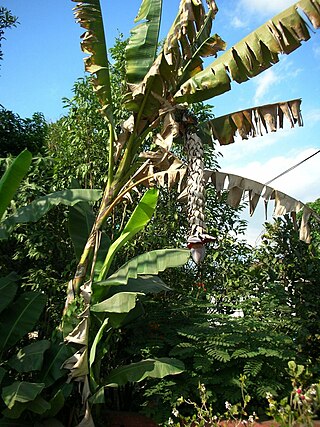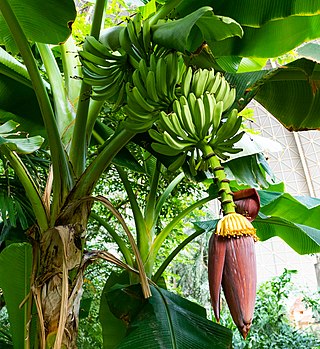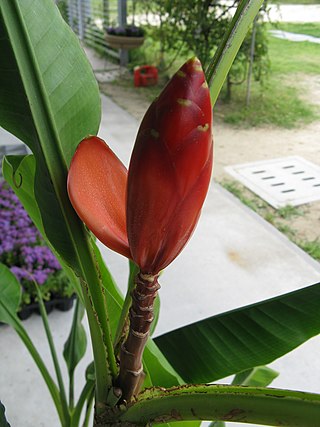
Abacá (Spanish), Musa textilis, is a species of banana endemic to the Philippines. The plant grows to 13–22 feet (4.0–6.7 m), and averages about 12 feet (3.7 m). The plant, also known as Manila hemp, has great economic importance, being harvested for its fiber, also called Manila hemp, extracted from the leaf-stems.

A banana is an elongated, edible fruit – botanically a berry – produced by several kinds of large herbaceous flowering plants in the genus Musa. In some countries, cooking bananas are called plantains, distinguishing them from dessert bananas. The fruit is variable in size, color, and firmness, but is usually elongated and curved, with soft flesh rich in starch covered with a rind, which may have a variety of colors when ripe. The fruits grow upward in clusters near the top of the plant. Almost all modern edible seedless (parthenocarp) bananas come from two wild species – Musa acuminata and Musa balbisiana. Most cultivated bananas are M. acuminata, M. balbisiana, or hybrids of the two.

Musa basjoo, known variously as Japanese banana, Japanese fibre banana or hardy banana, is a species of flowering plant belonging to the banana family Musaceae. It was previously thought to have originated in the Ryukyu islands of southern Japan, from where it was first described in cultivation, but is now known to have originated in subtropical southern China, where it is also widely cultivated, with wild populations found in Sichuan province. Its specific name is derived from its Japanese common name, bashō (芭蕉).

Musa balbisiana, also known simply as plantain, is a wild-type species of banana. It is one of the ancestors of modern cultivated bananas, along with Musa acuminata.

Musa acuminata is a species of banana native to Southern Asia, its range comprising the Indian Subcontinent and Southeast Asia. Many of the modern edible dessert bananas are from this species, although some are hybrids with Musa balbisiana. First cultivated by humans around 10 kya, it is one of the early examples of domesticated plants.

The Blue Java is a hardy, cold-tolerant banana cultivar known for its sweet aromatic fruit, which is said to have an ice cream-like consistency and flavor reminiscent of vanilla. It is native to Southeast Asia and is a hybrid of two species of banana native to Southeast Asia—Musa balbisiana and Musa acuminata.
Musa × alinsanaya is a Malesian tropical plant in the banana family (Musaceae), native to the Philippines. Only formally named in 2004, it is considered to be a hybrid between Musa banksii and Musa textilis. The flower bud is shiny green with purple inside. It produces small fruit with a high proportion of seeds.
Musa salaccensis, commonly called Javanese wild banana, is a Malesian tropical species of plant in the banana family native to the islands of Sumatra and Java, in Indonesia. It is placed in section Callimusa, members of which have a diploid chromosome number of 2n = 20.

Thai banana is a banana cultivar originating from Thailand, belonging to the triploid ABB banana cultivar group. This banana cultivar is one of the most important banana fruits in tropical and subtropical regions worldwide. Thai bananas contain many nutrients and are often eaten when ripe or prepared into many other dishes. Almost all parts of the Thai banana tree have useful uses for humans.
Musa hirta is a tropical Asian species of plant in the banana family native to Sarawak on the island of Borneo, in Malaysia. It is one of fourteen species of Musa endemic to the island of Borneo. It is placed in section Callimusa, having a diploid chromosome number of 2n = 20.

Musa coccinea, commonly known as scarlet banana or red-flowering banana, is a species of flowering plant in the banana and plantain family Musaceae, native to tropical China and Vietnam. It is a bat-pollinated evergreen perennial, placed in section Callimusa, having a diploid chromosome number of 2n = 20.
Musa ochracea is a plant in the banana and plantain family native to tropical Asia. The specific epithet, "ochracea", is a Latin word meaning "ochracaceous" (ochre-colored).

Musa × paradisiaca is a triploid cultivar of banana, belonging to the Cavendish banana subgroup, originating as the hybrid between Musa acuminata and Musa balbisiana, cultivated and domesticated by human very early. Most cultivated bananas and plantains are cultivars of this hybrid. Linnaeus originally used the name M. paradisiaca only for plantains or cooking bananas, but the modern usage includes hybrid cultivars used both for cooking and as dessert bananas. Linnaeus's name for dessert bananas, Musa sapientum, is thus a synonym of Musa × paradisiaca.

Musa beccarii is a species of wild banana, found in Malaysia, in Sabah. It is placed in section Callimusa.
Musa lawitiensis is a species of wild banana, native to the island of Borneo. It is placed in section Callimusa, having a diploid chromosome number of 2n = 20.

Musa lolodensis is a species of wild banana, occurring naturally from the Moluccas through to New Guinea. It is placed in section Callimusa, having a diploid chromosome number of 2n = 20. It is one of the possible parents of the cultivated Fe'i bananas.
Musa peekelii is a species of wild banana, native to eastern New Guinea and the Bismarck Archipelago. It is placed in section Callimusa, members of which have a diploid chromosome number of 2n = 20. It is a very tall plant, reaching over 10 m (33 ft), with a narrow green drooping bud. The ripe bananas are red with bright yellow flesh. It is one of the possible parents of the cultivated Fe'i bananas.
Bluggoe, Orinoco, Musa'Orinoco', or burro is a cultivar of banana.

Federal University of Agriculture, Zuru is a Nigerian tertiary institution in Zuru, Kebbi state ran fully by the Federal Government of Nigeria.












